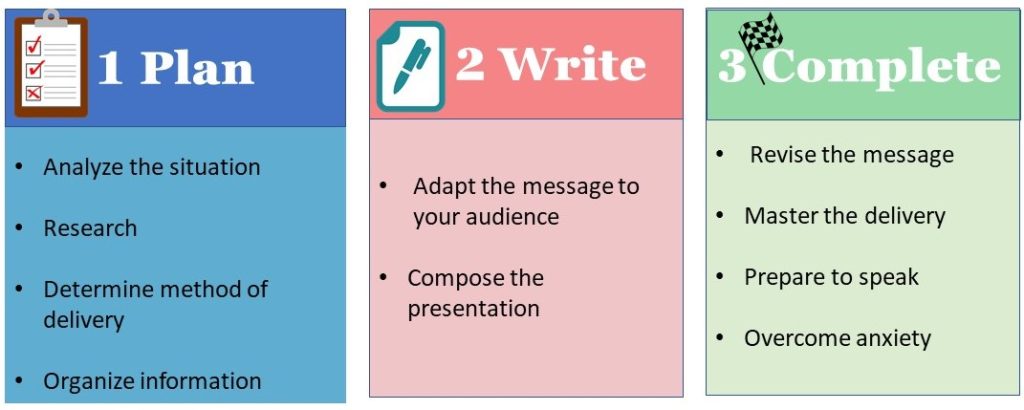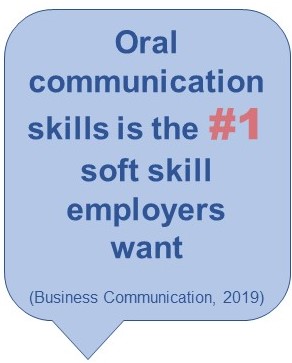77 Planning Your Presentation
Jordan Smith and Verna Johnson
At some point in your future career, you will likely be asked to give a presentation to your boss, colleagues, or even customers. Although this may seem intimidating, it is also an opportunity to demonstrate your knowledge and communication skills. Public speaking is an essential skill in most professional settings. In fact, public speaking has been called “the No. 1 predictor of success and upward mobility” (Business Communications, 2019, p. 431). College is the ideal time to develop and practice this skill. Knowing how to plan and deliver a well-organized presentation—whether in person or online—will help you stand out to future employers.
Planning Your Presentation
Planning a presentation is similar to planning other professional communication. It involves a systematic process of preparing, researching, outlining, and refining before delivery. This process takes time and effort but leads to better results for both the presenter and the audience. Figure 32.1 below shows the planning process.

Thorough planning not only helps reduce your anxiety but also improves your audience’s experience. People appreciate a clear, well-organized presentation—and when you’re prepared, it’s easier to stay calm and confident.
Strong presenters know their material, rehearse in advance, and speak naturally without reading every word. While some phrases may be memorized, most of the presentation should be delivered in a conversational tone. The presentation should be fully planned, but not rigidly scripted. This allows you to adapt to your audience in the moment.
Your organizational plan will serve as a roadmap, helping you stay focused and guiding your audience through your message. Just as there’s no substitute for practice and preparation, there’s no substitute for thoughtful planning.
Understanding the General Purpose
Most presentations serve one of three general purposes:
-
To inform
-
To persuade
-
To entertain, inspire, or engage
These categories help you think about how your message appeals to your audience’s understanding (inform), decision-making (persuade), or emotions and enjoyment (entertain). Before moving into the details of your specific topic, let’s watch a brief video overview of how to determine your presentation’s purpose.
Before discussing the specifics of creating a purpose statement for a presentation, watch Video 11.1 below which provides an overview of the process.
Video 11.1 | Purpose and Central Idea | Running Time: 4:07
Speech Purpose & Central Idea | Published by COMMpadres Media | Aug 16, 2016
Pinpointing the Specific Purpose
Once you’ve determined your general purpose, your next step is to write a specific purpose statement. This describes what you want to achieve and who your audience is. A specific purpose statement helps narrow your focus and guide what you include—and what you leave out.
To write an effective specific purpose statement, consider three elements:
- You (your interests, your background, past jobs, experience, education, major)
- Your audience
- The context or setting

Keeping these three in mind, you can now write a specific purpose using this formula:
[My purpose is] to [communication verb: inform, explain, demonstrate, describe, define, persuade, convince, argue] my [audience: classmates, coworkers, managers] about [topic or main message].
Example:
The purpose of my presentation is to demonstrate to my coworkers the value of informed intercultural communication.
Formulating a Central Idea Statement
While you don’t say your specific purpose out loud during your presentation, you do need to clearly communicate your main message. This is called the central idea statement. It’s similar to a thesis statement in an essay: it defines the topic and focus of your presentation.
Here are two examples that show how the specific purpose leads to the central idea:
| Specific Purpose | Central Idea |
|---|---|
| To explain to my classmates the effects of losing a pet on the elderly. | When elderly people lose their animal companions, they may experience serious psychological, emotional, and physical effects. |
| To demonstrate to my audience the correct method for cleaning a computer keyboard. | Your keyboard needs regular cleaning to work properly, and you can achieve that in four simple steps. |
Attribution
This section was adapted from Chapter 32 “Presentations – An Overview” in Communication Skills and is used under a Creative Commons Attribution 4.0 International license.
References
References are at the end of this chapter.
Media Attributions
- sidebar presentation
- presentation process


